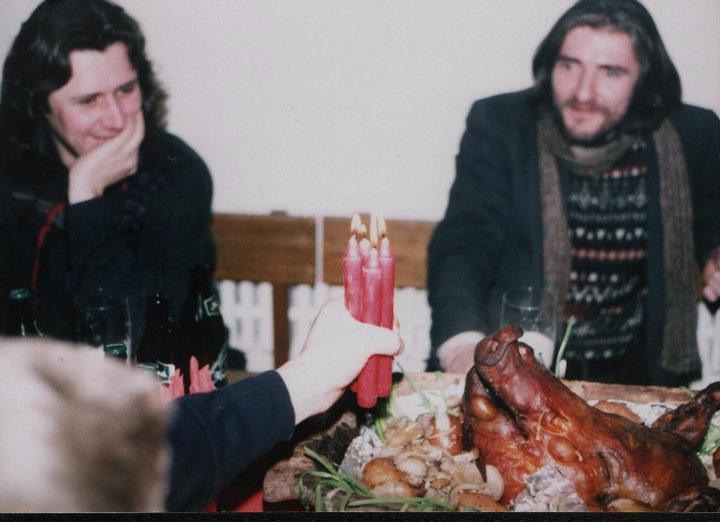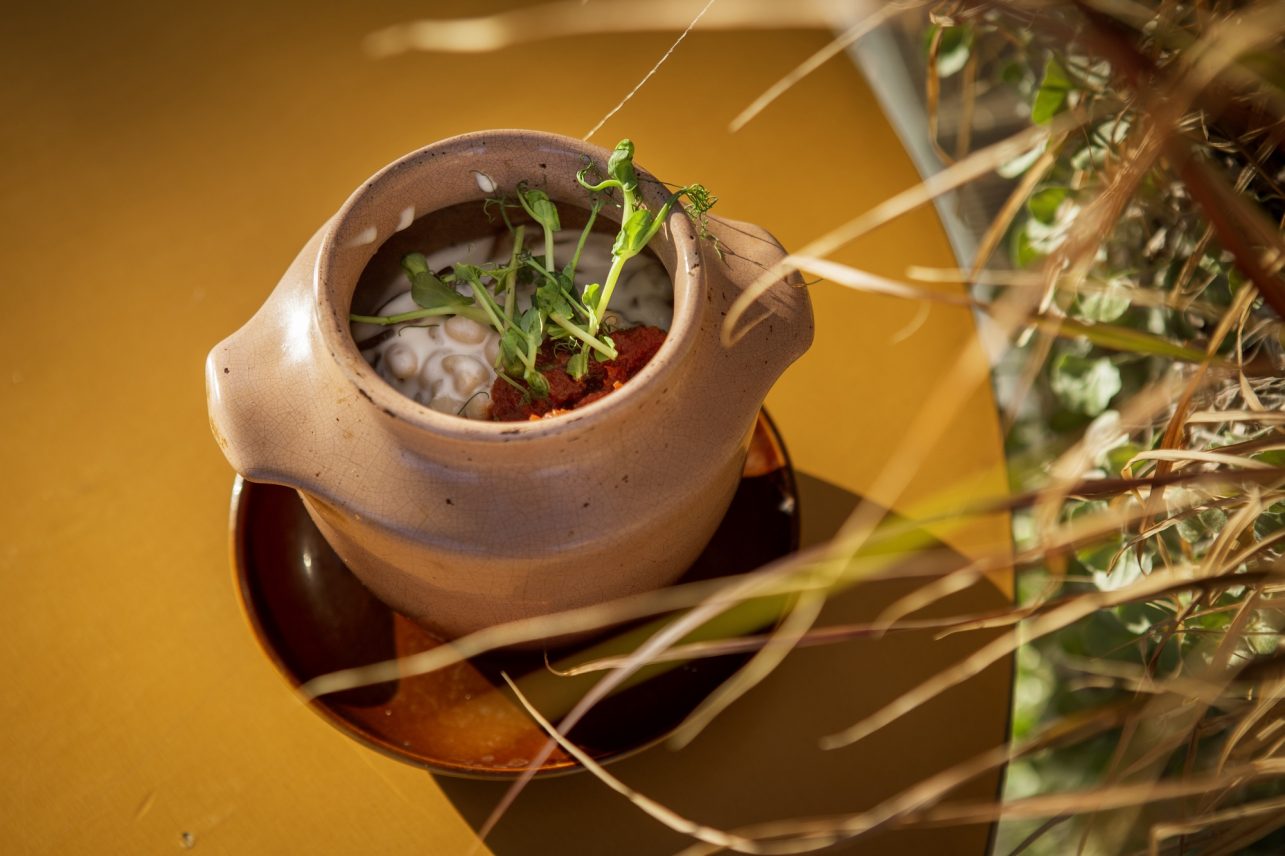Democracy and capitalism are rather recent companions of our everyday life. At the dawn of independence, we experienced perhaps the biggest turning point in the history of our country. New businesses started to emerge, and fresh opportunities opened up, but few of the characters from that era remain. However, Skliautas, the real ornament of Kaunas Old Town, has been welcoming visitors for three decades without interruption.
Next to the Lithuanian Artists’ Association
According to my interviewee Daiga Gaižutienė, the founder of Skliautas, although their business celebrated its 30th anniversary, the story began a little earlier. “The founding of the limited liability company in October of 1992 could be considered the beginning. We got into this adventure quite by accident. We had no experience in running restaurants or bars, but we were in a difficult situation, and we had to think about how to get out of it,” the founder opens up.

From the very beginning until now, the aura of this place is inseparable from the Lithuanian Artists’ Association. In the late Soviet period, during the reconstruction of the old town of Kaunas, the Lithuanian Artists’ Association’s Kaunas branch was given a large building in the Town Hall Square. They came up with the idea of setting up a private artists’ club here, which turned into Skliautas.
“We celebrate our anniversary on February 15, at a convenient time for everyone. Although during the first few years, we were not doing it, now it has become an important part of our community’s history. This date was decided by chance: we were going to open on the day of the restoration of the Lithuanian state, but due to the painful loss of the Lithuanian Artists’ Association’s director (he had lost his son), we opened the doors earlier. We also remember this every year,” Daiga continued.

Perhaps it is not surprising that the cafe, which first opened as a private artists’ club, began to attract and shape the community of Kaunas artists. Even now, it is often remembered that Skliautas is a bohemian place, full of culture and that special artistic aura.
“The very beginning was, let’s say, almost underground. It was popular for all organizations to have small bars where, for example, bankers gather, and that’s how we came to be. We were allowed to operate as a private club. Although there were still rubles, everyone had to pay a $1 club membership fee and could bring one friend. We also had a doorman who checked people, even though there is not much space here,” the head of Skliautas says.
Then came journalists, and newspaper workers. Then architects, and doctors. The audience here was always colorful, which, of course, was always mixed with people from the art world.
“Back in the day, many had their studios and workshops here. We bought our current banquet hall from Audronė Petrašiūnaitė, who worked here. Ceramicists were on the second floor. Many people also visited the workshop of sculptor Stasys Žirgulis, who still has a studio here. He’s a true intellectual. Students would sit with him and talk for hours,” Daiga Gaižutienė says.
What did Kaunas artists eat then and what do they eat now?
One can probably suspect that the generation of artists of the 1990s, who gathered here since the opening of Skliautas, were more interested in drinks than in food. The founder of the place does not try to hide this fact. She says that wine was the most important thing in the beginning, it just flowed. Whiskey also.
“Although now, of course, beer is the main drink in all of Lithuania, we have always paid great attention to wine. Back then, there were no good wines, or they cost an absurd amount of money. We drank Bulgarian, and Moldovan wine. And the names, I remember, were so funny: Bear blood, Ox blood. We spent a lot of money on wine. In the beginning, beer was only available in bottles, we didn’t have it,” the interviewee explains.
Later, everything changed, beer won. However, the founder of Skliautas did not abandon her passion for fermented grape drinks: she became a sommelier. The first better-quality wines were imported from Spain and France. Then came Italian, Argentinian, and Chilean ones.
The first Skliautas was a space of only 43 square meters. According to the founder, even though it was almost impossible, they did try to fit the kitchen somehow. At first, it was behind the bar, in a wall niche, the size of just a couple of square meters. There was a dual burner and a stove nearby. Therefore, the first dishes were dictated by necessity rather than wishes.
“Of course, there were those typical salads, herring – everyone ate that. We almost never offered Asian dishes; we wanted to focus on Lithuanian homemade food. When cooking shows started to appear and supply links emerged along with borders that started opening, I started going to Italy. The country then influenced the dishes we offered – typical Italian products, and fish. Now we offer a varied menu, but the most important thing is that the food is healthy”, the interviewer provides us with the history of the café’s kitchen.
What is the most important dish?
Since then, a lot has changed: this place has been open to everyone for a long time, the facade is decorated with a great sign, and the legendary Skliautas’ hot tub full of sports fans managed to appear and disappear, and the bohemians of Kaunas shrunk to Gintaras Patackas. What’s left is a barmaid that has been working here for 18 years and… a stew that has been warming the visitors up for 30 years.
“Since we didn’t have a normal kitchen at all, we chose a corner and started cooking the stew there. And it remains on the menu to this day: the legendary Skliautas stew. It is easy to prepare, and it can be kept for a long time: when the kitchen closes, the barmaid can also heat it up. It is served in clay cups,” Daiga reveals the secret of the oldest dish on the menu.
As she says, many things have happened in the past. For example, for some time there was a tradition of roasting a pig’s head. Especially on birthdays. “Many ceramicists would come because next to our building, the premises above belonged to Kaunas restorers, and there was a pottery kiln there. One day our good friend came and said, “You could roast a pig’s head in such a hot furnace.” Gražina then marinated, baked it, and served it. This is how the tradition of serving such an unconventional and interesting, and at the time also luxurious, dish was born during these first birthdays.”

Stew recipe
You will need a pork neck and (in equal parts) potatoes, carrots, onions, beans, and mushrooms.
Also: bay leaves, allspice, hot spices, tomatoes, garlic, oregano, salt, mayonnaise, and parsley.
● We peel and chop the potatoes, carrots, onions, and mushrooms into small pieces.
● Boil the beans.
● We cut the pork neck into small pieces and fry them.
● We also sauté carrots, onions, and mushrooms in different pans.
● We add raw potatoes and everything we cooked in equal parts to the clay pot. We put beans, bay leaf, allspice, hot spices, a little water on top, and stew in the oven for 1.5 hours.
● While it is cooking, we prepare the sauce: we mash tomatoes, garlic, oregano, and salt.
● Serve with prepared sauce, a spoonful of mayonnaise, and a handful of parsley.

